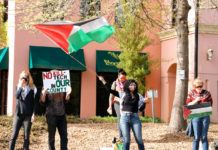“My education in the Santa Rosa High School woodworking class
was more important than I ever dreamed,” said George Greeott last
week while sitting at the dining room table in his home on Chalk
Hill Road. Though he laid aside woodworking for several decades, in
the past half century Greeott has made the most of those
skills.
Now 92, Greeott has created hundreds objects from wood — many
of them functional, many more charmingly useless. It is typical of
George, as he prefers to be addressed, that he looks for a way to
give someone else the credit for his prodigious accomplishments,
even if it means recognizing a high school teacher of 75 years
past.
George did not always have time for working with wood. He began
working on the family’s 167-acre ranch when it was purchased by his
father, John Greeott, in 1928. George was 18 at the time. He
married Isabel Sicco of Cotati in 1935 and leased the ranch from
his father the following year.
In the late 1930s, as he continued to grow prunes, grapes and
apples he served as the Hill District trustee of the Windsor Union
School District.
After his father passed away George paid other family members
for their shares in the ranch and became its sole owner in 1950. “I
consider it important that people know it was not handed down to
me,” Greeott said. “When you have to pay for it, you had better be
successful.”
The year after he bought the ranch Greeott began making a series
of improvements, starting with a new dam. It was among the earliest
man-made dams in Sonoma County.
He was surprised when, in 1958, he received an award “For
Outstanding Accomplishment in Soil Conservation” from the Santa
Rosa Soil Conservation District.
“I wasn’t even aware they had an award like that,” he said. “I
was just trying to improve my ranch.”
Greeott is amused at how thinking has changed since he received
the award. “Some people now say, ‘George drained a patch of land
that should have been left wet,'” he noted with a grin and a
shrug.
George and Isabel owned the ranch for only 11 years. In 1961,
with their children grown and on their own, George said to Isabel
one day, “You know, we don’t need this ranch like we used to need
it.” Never one to sit still, he was ready for fresh challenges.
So they sold all but a strip along the edge of the property. The
parcel they kept included a hilltop homesite and a spot for a new
lake. George began building a new dam as soon as the deal was
signed. He also designed a new home and began building it, with the
help of a building contractor, in 1962. George and Isabel moved
into the house in 1964, but not before he had filled it with
cabinets of his own design and construction. The old woodworking
skills, long dormant, were now resurgent and could no longer be
easily quelled.
But his vision for the property consumed much of his time. He
brought more than 200 tons of fieldstone to the site in his own
two-ton truck, creating hillside terraces with pick and shovel. His
friend Don DuVander helped George move the larger rocks now evident
in the site’s landscaping.
In 1982 George created his first wood carving. A semi-abstract
object that looks a bit like a tall stack of blocks, it was created
with a wood rasp from a piece of Monterey pine.
At that point, in his early 70s, George no longer felt driven to
work more than he cared to. “I had time on my hands to choose what
I wanted to do,” he said, “so I got into carving seriously, once I
found out I was enjoying it.”
George and Isabel traveled the world in the 1980s, visiting
England, Holland, Switzerland, Germany, Italy, Australia, New
Zealand, Fiji and the East Coast of the United States. “We were
fortunate enough to take some pretty good trips,” he said.
Not content with one artistic medium, Greeott began creating
metal sculptures of arc welded railroad spikes and horseshoes.
There were leap-frogging children, arm wrestlers, ice skaters, a
high jumper doing the Fosbury Flop, a PG&E repairman on a
pole.
And George kept carving wood. “I do a cross-section of what you
see in this world,” he said. The subjects to which he returns most
frequently are gracefully-proportioned birds, a wild profusion of
abstract designs, and — most often — meticulously-detailed
carvings of hand tools. There are dozens of wrenches, screw
drivers, hammers, augers and planes. There are chains carved from
single blocks of wood.
A vein of whimsy runs through much of George’s work. On the back
of a carefully-scaled, non-functional wooden lock is inscribed
“Greeott Useless Lock Company.” A hollow abstract carving sporting
a surface filled with holes carries the title, “A corrupt
politician’s head.”
Of his bird carvings George insists, “You cannot carve these
without using your bird brain.” One of his metal sculptures
portrays a drunk passed out over a bottle.
His most recent carving is a pair of giant eye-glasses created
from walnut and manzanita wood, perched on a manzanita nose. “I
wanted the nose to be red,” he said.
Not given to a sedentary life, even as a nonagenerian, Greeott
doesn’t devote all his time to carving wood. Living alone since
Isabel died seven years ago, George does his own cooking and
housekeeping. He has recently cleared a fresh piece of land and
begun a new project. “I’m highly enthused about my new vegetable
garden,” he said. He anticipates a year-round harvest.
As dozens of trophies, plaques and fabric patches attest,George
has also kept up with his horseshoe pitching hobby. In 1995 he was
tournament champion in the Seniors Championship at Vallejo, scoring
a 57 percent ringer average. He was champion in three 2002
horseshoetournaments.
Over the years George also found time to collect artifacts from
the ranch and the surrounding area. Many years ago a Pomo Indian
camp had been on the land.
A large collection of grinding bowls has been determined by an
anthropologist to be 6,000 to 10,000 years old. A revolving
circular glass case, which Greeott designed, displays 383 Pomo
arrowheads and stone hand tools.
Greeott’s collection also includes a wide array of artifacts a
mere 80 to 100 years old. Some came from his father’s Alpine
Winery. There is a wine pump purchased in 1893, a French instrument
for measuring alcohol content purchased in 1911. There is a crusher
and a wine press.
Coopers tools and cobblers equipment fill shelves along with row
after row of antique bottles. There are ancient telephones, and, in
one corner, the school bell from the old Hill School.
A public display of Greeott’s many collections will open at the
Windsor branch of the Sonoma County Regional Library on February
18. Proceeds will benefit the Windsor Historical Society’s effort
to create a new Historical Museum.
In Greeott’s mind, the museum is the perfect final destination
for his work. “I never sold my work,” he said. “I wanted to create
collections. If I had started selling things, then I’d have been in
business against my will.”
Greeott has started an endowment fund for the museum project. He
hopes the library display of his work will create more interest and
more support for Windsor’s Historical Museum.
59.6
F
Healdsburg
April 17, 2024







